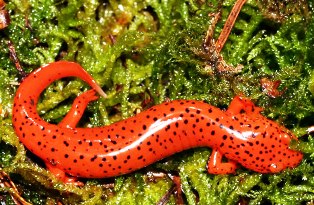2014- The year of the salamander
Salamanders are amphibians that have long tails and moist skin. All salamanders must keep their skin moist because it is comparatively soft and does not protect them against loss of moisture. For this reason they require damp environments. Even the land species are usually found in shady, wooded areas near water. Some burrow into damp ground. With the exception of sirens and amphiumas, salamanders look basically like scaleless lizards. Floridians sometimes call salamanders "spring lizards" because they are often seen near springs. But unlike lizards, salamanders have neither claws, nor scales, and their legs are so short that their bellies drag on the ground. Being amphibians, most salamanders undergo metamorphosis. Unlike frogs salamanders don't lose their tails when they change from the larval stage to adults. What would be called the tadpole stage in frogs is called the larval stage in salamanders. Salamanders can regenerate limbs as well as tails and can even regenerate eye retinas and severed optic nerves.
FWC biologists are currently working to restore the native habitat of the reticulated flatwoods salamander, one of Florida’s own endangered amphibians – The flatwoods salamander is medium-sized, reaching an adult length of 5 inches and its body color ranges from silvery gray to black, with the back heavily mottled with a variable gray cross-band pattern. The underside is plain gray with faint creamy blotches. The head is small and equal to the neck in diameter. The flatwoods salamander used to crawl over 100 million acres of longleaf pine habitat in the Southeastern United States. Now there is less than 3 million acres of habitat left - most of it in 11 wetland-rich Florida counties.
The best time to flatwoods salamanders are at night, when they come out for food. They are solitary creatures who live alone and spend most of the daylight hours in underground burrows or in cool, damp crevices under rocks or logs. They have fragile bodies and should be handled as little as possible.




Comments
Post a Comment